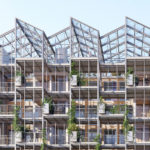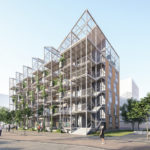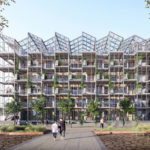Revitalizing Kellogg's Site: Unique Residential Greenhouse in Bremen
Project's Summary
Revitalizing the Kellogg's Site: A New Urban District on the Weser
The former Kellogg’s site on the Überseeinsel in Bremen is undergoing a metamorphosis to become a vibrant urban district that combines spaces for living, working, learning, leisure, and greenery. The Neu-Stephani quarter, situated on the banks of the Weser, is a prime example of this transformation. The waterfront location, combined with residential apartments, educational facilities, and open spaces, makes it a desirable destination for all. However, one unique feature stands out from the rest - a residential greenhouse.
A Residential Greenhouse Unlike Any Other
The residential greenhouse project on the Neu-Stephani quarter in Bremen is a one-of-a-kind project created by the Delugan Meissl Associated Architects architectural studio. The building comprises three principal components - a timber residential block, a superimposed greenhouse, and a connecting access pergola. The residential block is a fully prefabricated, modular timber structure that is assembled on site. The building contains a range of residential typologies, including standard modules of around 42 m² (2 rooms) and 54 m² (3 rooms), studio apartments measuring 30 m², and optimized family apartments with 85 m² (3 rooms plus office area). The building can accommodate between 30 and 54 residential units, depending on how the modules are combined.
A Unique Energy Concept
The residential units are efficiently heated via their own core, which meets the varying temperature requirements of the living, sanitary, and sleeping areas. The heat extracted from the apartments is then redirected to the greenhouse, where it is used to support the all-year-round growing of plants. The interaction between the residential building and the greenhouse creates a unique energy concept that benefits the environment and the residents.
A Communal Space for Exchange
The communal balconies and open spaces in front of the apartments are connected to the generous pergola, creating an open greenhouse. This design facilitates social networking among the residents and creates areas for exchange. The communal space is an added value not only for the residents but also for the immediate surroundings and the environment.
In conclusion, the residential greenhouse project on the Neu-Stephani quarter in Bremen is an innovative example of how architecture can combine function, sustainability, and beauty. The project is a testament to the creativity and ingenuity of the Delugan Meissl Associated Architects architectural studio. The Neu-Stephani quarter is a unique urban district that offers a new way of living, working, and socializing. It is an exciting development that is sure to inspire future urban planning projects.
Read also about the MoederscheimMoonen Architects' Clear and Purist Design for Utrecht Retail Pavilion project



